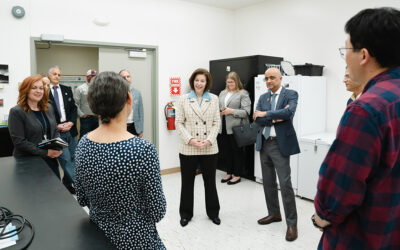Reno, Nev. (January 3, 2018): To protect communities in arid landscapes from devastating wildfires, preparation is key. New research from the Desert Research Institute (DRI) in Reno may aid in the prevention of large fires by helping meteorologists and fire managers in the Southwestern U.S. to forecast periods of likely wildfire activity.
Each summer, from June through September, a weather pattern called the North American monsoon brings thunderstorms to the Southwestern U.S., with lightning that often sparks wildfires.
The new study, which published in the International Journal of Climatology, examined twenty common weather patterns that occur during the North American monsoon season, and identified relationships between certain weather patterns and times of increased fire activity.
One of the most problematic weather patterns, the team learned, was when dry and windy conditions gave way to lightning storms in May and June – a time when fuels tended to be at their driest and monsoon rains had not yet soaked the region with added moisture. When lightning storms were followed by another hot, dry, windy period, increased fire activity was even more likely.
“A lot of fire meteorologists know from experience that this is how things happen, but our study actually quantified it and showed how the patterns unfold,” said lead author Nick Nauslar, Ph.D., who completed this research while working as a graduate student at DRI under Tim Brown, Ph.D. “No one had ever really looked at large fire occurrence in the Southwest and how it related to atmospheric patterns.”
To identify problematic weather patterns, Nauslar and his team looked at monsoon season weather data collected from April through September over the 18-year period from 1995-2013. They then classified wildfire activity over the same period into days or events that were considered “busy” by fire managers in their study area, and used an analysis technique called Self-Organizing Maps to detect relationships between the two datasets.
In addition to identifying relationships between specific weather patterns and fire activity, their analysis also looked for patterns in wildfire occurrence and fire size throughout the season. Analysis of more than 84,000 wildfires showed that although July was the month that the most wildfires occurred, wildfires that occurred during the month of June (prior to the arrival of much monsoonal moisture) were more likely to develop into large fires. In July and August, when the heaviest monsoonal precipitation typically occurs, the percentage of fires that developed into large fires decreased.
“Our goal with this study was to provide fire weather meteorologists in the region with information to help inform fire forecasts, and I think we were able to identify some important patterns,” said Brown, Director of the Western Regional Climate Center at DRI.
Nauslar, who is now employed as a mesoscale assistant and fire weather forecaster for the National Oceanic and Atmospheric Administration (NOAA) Storm Prediction Center in Norman, Oklahoma, hopes that the findings of this study will help fire managers in the Southwest to proactively identify periods when wildfires are more likely to occur, and to allocate firefighting resources accordingly.
“I think a lot of what we learned confirms forecaster experience about the types of atmospheric patterns that are problematic with regard to wildfire occurrence in the Southwest,” Nauslar said. “I hope that people in operations can really use this information, and help refine it and build upon it.
Other DRI scientists who contributed to this research included Benjamin Hatchett, Ph.D., Michael Kaplan, Ph.D., and John Mejia, Ph.D. The full study, titled “Impact of the North American monsoon on wildfire activity in the southwest United States,” is available online from the International Journal of Climatology: https://rmets.onlinelibrary.wiley.com/doi/abs/10.1002/joc.5899
The Desert Research Institute (DRI) is a recognized world leader in basic and applied interdisciplinary research. Committed to scientific excellence and integrity, DRI faculty, students, and staff have developed scientific knowledge and innovative technologies in research projects around the globe. Since 1959, DRI’s research has advanced scientific knowledge, supported Nevada’s diversifying economy, provided science-based educational opportunities, and informed policy makers, business leaders, and community members. With campuses in Reno and Las Vegas, DRI serves as the non-profit research arm of the Nevada System of Higher Education. Learn more at www.dri.edu, and connect with us on social media on Facebook, Instagram and Twitter.
Northern Nevada Science Center
2215 Raggio Parkway
Reno, Nevada 89512
PHONE: 775-673-7300
Southern Nevada Science Center
755 East Flamingo Road
Las Vegas, Nevada 89119
PHONE: 702-862-5400


